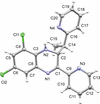issue contents
August 2023 issue

Cover illustration: The single-crystal X-ray diffraction structure of the triphenyltin(IV) chloride–cyclohexyldiphenylphosphane oxide (1/1) cocrystal features a short and directional tetrel bond between tin and oxygen. The tin–oxygen distance is 2.346 (4) Å, representing 62% of the sum of the van der Waals radii of Sn and O. The Cl—Sn⋯O angle is 174.0 (1)° and this nearly linear arrangement is consistent with a tetrel bond formed via a σ-hole opposite the tin–chlorine covalent bond. Some weak C—H⋯Cl interactions are noted between adjacent molecules. See: Liyanage, Ovens & Bryce [IUCrData (2023). 8, x230637].
inorganic compounds


 access
accessmetal-organic compounds


 access
access

 access
access

 access
access

 access
access

 access
access

 access
access

 access
access

 access
accessorganic compounds


 access
access

 access
access

 access
access

 access
access

 access
access

 access
access

 access
access
 journal menu
journal menu



























![[publCIF]](/logos/authorchecklist11.gif)





